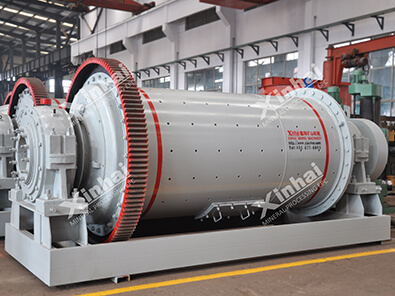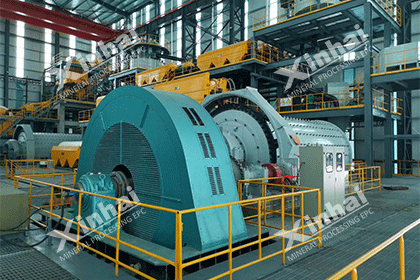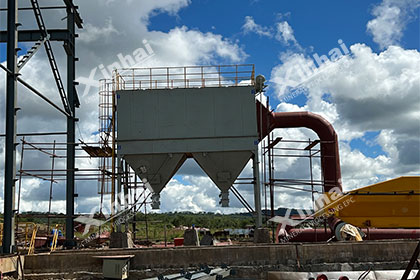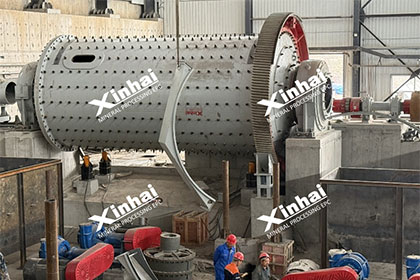Overflow Type Ball Mill VS Grid Type Ball Mill
 Laura
Laura
 Jun 30, 2022
Jun 30, 2022
 2636
2636
If you want to know more details about equipment, solutions, etc, please click the button below for free consultation, or leave your requirements!
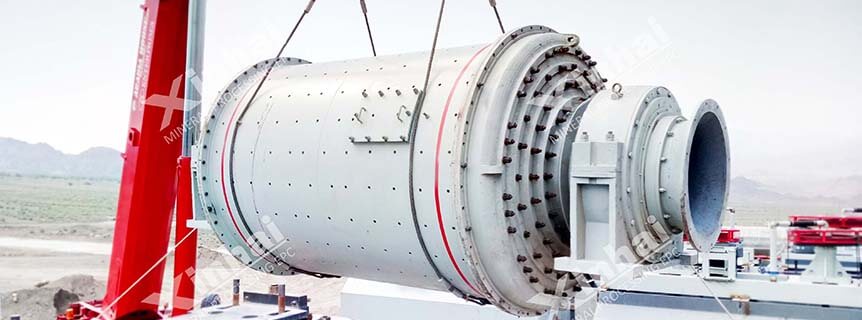
( Ball mill in a 1500tpd copper mine in Pakistan )
01 What Is A Ball Mill?
BackThe ball mill is the key equipment for the material to be crushed and then crushed. It is a kind of equipment that loads a certain number of steel balls as grinding media in its cylinder.
Ball mills are widely used in cement, silicate products, new building materials, refractory materials, fertilizers, black and non-ferrous metal beneficiation and glass ceramics and other production industries, dry grinding or wet grinding of various ores and other grindable materials grind. Ball mills are suitable for grinding various ores and other materials, and are widely used in mineral processing, building materials and chemical industries. The characteristics of the ball mill are mainly reflected in the relatively large crushing, simple structure and convenient operation. With the development of technology, ball mills are gradually innovating and upgrading, becoming more and more energy-saving and environmentally friendly, and the market demand for ball mills is also increasing. So let's introduce how the ball mill works.
02 How Does A Ball Mill Work?
BackThe ball mill adopts a horizontal cylindrical rotating device, which is driven by an outer gear. The material enters the first chamber of the mill spirally and evenly from the feeding device through the feeding hollow shaft. There are stepped lining plates or corrugated lining plates in the chamber, and steel balls of different specifications are installed inside. The rotation of the cylinder generates centrifugal force to bring the steel balls to a certain height. After falling down, it has a heavy impact and grinding effect on the material. After the material reaches the rough grinding in the first warehouse, it enters the second warehouse through the single-layer partition board. The warehouse is inlaid with a flat lining plate and has steel balls to further grind the material. The powder is discharged through the discharge grate to complete the grinding operation.
The main function of the steel ball in the ball mill is to impact and crush the material, and also play a certain role in grinding. The quality of the crushing effect directly affects the grinding efficiency and ultimately affects the output of the ball mill. The parameters mainly include the size of the steel ball, the series of ball diameters, the proportion of balls of various sizes, etc.
According to the different discharge methods of the ball mill, we divide the ball mill into an overflow type ball mill and a lattice type ball mill. Below we will learn more about the difference between overflow type ball mill and grid type ball mill.
03 Overflow Type Ball Mill VS Grid Type Ball Mill
Back#1. Difference in Structure
Grid Type Ball Mill
The grid type ball mill is equipped with a grid plate on the discharge side, hence the name.
There are many 7-20mm discharge holes on the grid plate. The material ground by the ball mill will pass through the grid plate, and the side of the grid plate near the discharge end is equipped with a slurry lifting device, which is a radial rib, which divides the grid plate and the end cover into several passages. Sector towards the hollow journal.
When the ball mill rotates, the radial ribs play the role of lifting the pulp, and the pulp discharged from the small holes on the grid plate is lifted to the hollow shaft journal for discharge, and then discharged from the ball mill through the hollow shaft.
Overflow Type Ball Mill
The structure of the overflow type ball mill is basically the same as that of the grid type ball mill. The difference is that the discharge end of the overflow type ball mill has no discharge grid plate.
In addition, the inner surface of the hollow journal bushing of the overflow type ball mill is equipped with a reverse spiral blade, which can return the small steel balls and oversized coarse particles overflowing from the slurry back to the ball mill.
The overflow type ball mill discharges the ore mainly because the slurry itself is higher than the lower edge of the hollow journal bushing and overflows by itself, and the overflow type ball mill is also named for this reason.
#2. Differences in How They Work
Grid Type Ball Mill
The working principle of the grid ball mill is mainly to rotate slowly through the transmission device, and the material is fed from the feeding end of the cylinder. Due to the continuous feeding of the material, the pressure of the material in the cylinder causes the material in the cylinder to move from the feeding end to the discharging end. The material that reaches the finished particle size is discharged from the discharge end of the cylinder.
During wet grinding, the material is carried out by the water flow; when dry grinding, the material is carried out by the air flow. The mill has a discharge grid at the discharge end, and the mill relies on the grid plate to force the discharge of ore.
Overflow Type Ball Mill
The overflow type ball mill is driven by a low-speed synchronous motor, which is connected with the pinion device through the air clutch to drive the peripheral large wheel to reduce the transmission and drive the rotary part to rotate; the cylinder is equipped with appropriate grinding media (steel balls) and materials, grinding Under the action of centrifugal force and frictional force, the mineral medium and material are lifted to a certain height with the rotation of the cylinder, and then dropped at a certain linear speed. The material to be ground is continuously fed into the cylinder from the feeding part. Inside the body, it is smashed and ground by the moving ore and steel balls, as well as the collision between the balls and between the balls and the cylinder liner. And through the power of continuous feeding, the product is discharged out of the machine to complete the grinding process for the next stage of processing.
#3. Difference in Performance
Grid Type Ball Mill
Compared with the overflow type ball mill, the grid type ball mill is a low-level forced ore discharge. The phenomenon of material overgrinding.
In addition, the grid-type ball mill has a large amount of balls, large and small steel balls can be loaded and small steel balls will not be discharged. Under the same conditions, the grid-type ball mill has higher grinding efficiency and larger production capacity, but its structure is complex, its quality is larger, and its price is relatively higher.
Overflow Type Ball Mill
The overflow type ball mill has a simple structure and is easy to manage and maintain, but its discharge liquid level is high, the material stays in the mill for a long time, and the production capacity is lower than that of the lattice type ball mill of the same specification, which is easy to cause overgrinding.
Generally, the productivity of lattice mills is 10%-25% higher than that of overflow mills, and the power consumption is 10%-20% higher than that of overflow type ball mills. The grid mill consumes a lot of power, but its production efficiency is high. If it is calculated by ton/kWh, its efficiency index may be higher.
#4. Differences in Mine Discharge Methods
Grid Type Ball Mill
The discharge method of the grid ball mill is through the form of sieve plate. The overflow type has no sieve plate (the end liner is used, which is the same model as the grinding head). Overflow type; the material level of the ball mill is higher than the discharge port, and it overflows automatically, but there is no discharge grid in the discharge of the cylinder. Furthermore, the inner surface of the hollow journal bushing is equipped with a reverse spiral blade, which can overflow the slurry. The outflowing small balls and coarse ore blocks return to the mill, which is called overflow type ball mill. Compared with the overflow type ball mill, the advantages of the grid type ball mill are: the slurry surface of the discharge port is low, the slurry can pass through quickly, which can reduce the over-grinding of ore; It will not be discharged, and it can also form good working conditions; under the same conditions, the production capacity is high, and the power consumption is low. The disadvantage is that the structure is slightly complicated.
Overflow Type Ball Mill
However, the overflow type ball mill has a simple structure, convenient management and maintenance, so the operation rate is relatively high. Generally, the overflow type should be used when the grinding fineness is fine, and the lattice type should be used when the grinding fineness is coarse (it can avoid the adverse effect of over-grinding on the separation).
The advantage of the grid type ball mill is that the speed of the ore is fast, which can reduce the over-grinding of the ore, and at the same time can increase the output per unit volume, which is higher than the overflow type ball mill. The disadvantage is that the structure is complex, the grid plate is easy to block when the mine is quarried, and the maintenance is difficult and complicated. The advantage of the overflow type ball mill is that the structure is simple and the maintenance is convenient. Because the discharge pipe is cast with troublesome threads, the large ore and steel balls are not easy to discharge. The disadvantage is that the unit volume production capacity is low, the processing capacity is low, and it is prone to crushing.
#5. Difference in Usage
Grid Type Ball Mill
Grid type ball mills are mostly used for rough grinding. They are often used in single-stage grinding or the first stage of two-stage grinding in dressing plants. During closed-circuit grinding operations, the grinding fineness ranges from 50% to 70%-0.074. About mm, the grinding and grading work is completed with the combination of spiral classification.
Overflow Type Ball Mill
The overflow type ball mill can be used for one-stage grinding and two-stage grinding. Besides, it can also be used for regrinding in the middle of two-stage grinding. In the market, most of the overflow type ball mills are used for the regrinding of materials in the second-stage grinding with the water cyclone. The selection basis of the overflow type ball mill is mainly based on the processing capacity of the material. Generally, when the processing material is larger than ф4000mm, the overflow type ball mill and the cyclone are selected to form the grinding circuit. Grid type ball mills are mostly used for rough grinding. They are often used in single-stage grinding or the first stage of two-stage grinding in dressing plants. During closed-circuit grinding operations, the grinding fineness ranges from 50% to 70%-0.074. About mm, the grinding and grading work is completed with the combination of spiral classification.
#6. Difference in Grinding Effect
Grid Type Ball Mill
The grid type ball mill can realize low-level forced ore discharge due to the existence of the unique grid plate and the fan-shaped chamber. The ball mill is 10%-25% higher, suitable for one-stage rough grinding or the first stage of two-stage grinding, and can also be used to grind easily crushed and soft ores. When the particle size of the material needs to be ground to a uniform product of 48-65 meshes, it is better to use a grid-type ball mill.
Overflow Type Ball Mill
Due to the structure of the discharge end of the overflow type ball mill, the slurry in the mill has a certain inclination towards the discharge end. When the height of the slurry surface is higher than the low busbar of the inner diameter of the discharge port, the slurry overflows out of the ball mill. This is a non-forced high material level discharge, and the discharge speed is slow, so the mineral material stays in the machine for a long time, and the effective effect of the medium is also low. Therefore, the overflow mill is severely over-ground, and the processing capacity is also higher than that of the same specification. The lattice type is low. However, the overflow type ball mill has various transmission modes, high transmission efficiency, small footprint, and convenient maintenance. At the same time, the particle size of the overflow type ball mill is generally less than 0.2mm.
04Summary
BackIn summary, we can draw the following conclusions.
Grid Type Ball Mill
Advantages: The discharge speed is fast, which can reduce the over-grinding of the crushed stone, and at the same time can increase the output per unit volume, which is higher than the overflow type ball mill;
Disadvantages: The structure is complex, the grid plate is easy to be blocked when discharging ore, and the maintenance is difficult and complicated, and the operation rate is relatively low.
Overflow Type Ball Mill
Advantages: simple structure, convenient maintenance, because the discharge pipe is cast with reverse threads, the large ore and steel balls are not easy to be discharged out of the machine;
Disadvantages: The production capacity per unit volume is low, and it is easy to produce excessive crushing.
The two types of ball mills have their own characteristics in terms of use and performance. Users should clarify their own production requirements, whether coarse or fine grinding, and how much output is required, so as to choose the most suitable type of ball mill.
 +86 183 3575 8886
+86 183 3575 8886 pinklaurabao@gmail.com
pinklaurabao@gmail.com




 Message
Message Chat Now
Chat Now


